Foreword / YouTube Video Review
These speakers were loaned to me by their owner for review.
The review on this website is a brief overview and summary of the objective performance of this speaker. It is not intended to be a deep dive. Moreso, this is information for those who prefer “just the facts” and prefer to have the data without the filler. The video below has more discussion.
Information and Photos
Specs from the manufacturer can be found here.
- matched pair of stand-mount speakers
- three-way design:
- 8” woven Kevlar woofer
- 5” woven Kevlar midrange
- 1” woven textile soft dome tweeter
- frequency response: 40-20,000 Hz (±3dB)
- recommended amplifier power: 25-200 watts
- sensitivity: 90 dB
- nominal impedance: 6 ohms
- minimal impedance: 3.5 ohms
- crossover frequency: 630Hz & 2.4kHz
- bass-reflex design with dual rear-firing ports
- binding posts accept pins, banana connectors, spade connectors, or bare wire
- removable cloth grille
- real-wood veneer finish
- veneer leaves for the left and right speakers are crafted from the same piece of timber
- they’re hand-matched to provide an aesthetically pleasing “mirror” image of each other
- 11-7/8"W x 22-5/16"H x 14-1/16"D each (speaker only)
- weight: 40.5 lbs. each
- warranty: 5 years
The current price is approximately $1500 USD for a pair. As of the time of this review’s posting there is a sale for the pair + matching stands for this same price at Crutchfield (affiliate link).
Below is a shot inside the enclosure, through the woofer hole and up toward the midrange enclosure. Yes, the midrange does have a separate enclosure which is a nice change. It does look like sonotube (you construction folks or DIY subwoofer fans will know exactly what I’m talking about). Also note the screen material on the ports to keep the enclosure liner to keep from getting clogged in a port.
CTA-2034 (SPINORAMA) and Accompanying Data
All data collected using Klippel’s Near-Field Scanner. The Near-Field-Scanner 3D (NFS) offers a fully automated acoustic measurement of direct sound radiated from the source under test. The radiated sound is determined in any desired distance and angle in the 3D space outside the scanning surface. Directivity, sound power, SPL response and many more key figures are obtained for any kind of loudspeaker and audio system in near field applications (e.g. studio monitors, mobile devices) as well as far field applications (e.g. professional audio systems). Utilizing a minimum of measurement points, a comprehensive data set is generated containing the loudspeaker’s high resolution, free field sound radiation in the near and far field. For a detailed explanation of how the NFS works and the science behind it, please watch the below discussion with designer Christian Bellmann:
The reference plane in this test is at the tweeter height but middle of the baffle (the speaker has an offset tweeter by approximately 20mm). Upon listening to and measuring the speakers I found that the best overall response for this speaker is when the grilles are on. Therefore, the data for this speaker is based on grille on, though, I do provide some data for grille off at the end of the review. While generally this isn’t standard, I encourage you to consider using the grilles. The performance is truly better this way.
Measurements are provided in a format in accordance with the Standard Method of Measurement for In-Home Loudspeakers (ANSI/CTA-2034-A R-2020). For more information, please see this link.
CTA-2034 / SPINORAMA:
The On-axis Frequency Response (0°) is the universal starting point and in many situations it is a fair representation of the first sound to arrive at a listener’s ears.
The Listening Window is a spatial average of the nine amplitude responses in the ±10º vertical and ±30º horizontal angular range. This encompasses those listeners who sit within a typical home theater audience, as well as those who disregard the normal rules when listening alone.
The Early Reflections curve is an estimate of all single-bounce, first-reflections, in a typical listening room.
Sound Power represents all of the sounds arriving at the listening position after any number of reflections from any direction. It is the weighted rms average of all 70 measurements, with individual measurements weighted according to the portion of the spherical surface that they represent.
Sound Power Directivity Index (SPDI): In this standard the SPDI is defined as the difference between the listening window curve and the sound power curve.
Early Reflections Directivity Index (EPDI): is defined as the difference between the listening window curve and the early reflections curve. In small rooms, early reflections figure prominently in what is measured and heard in the room so this curve may provide insights into potential sound quality.
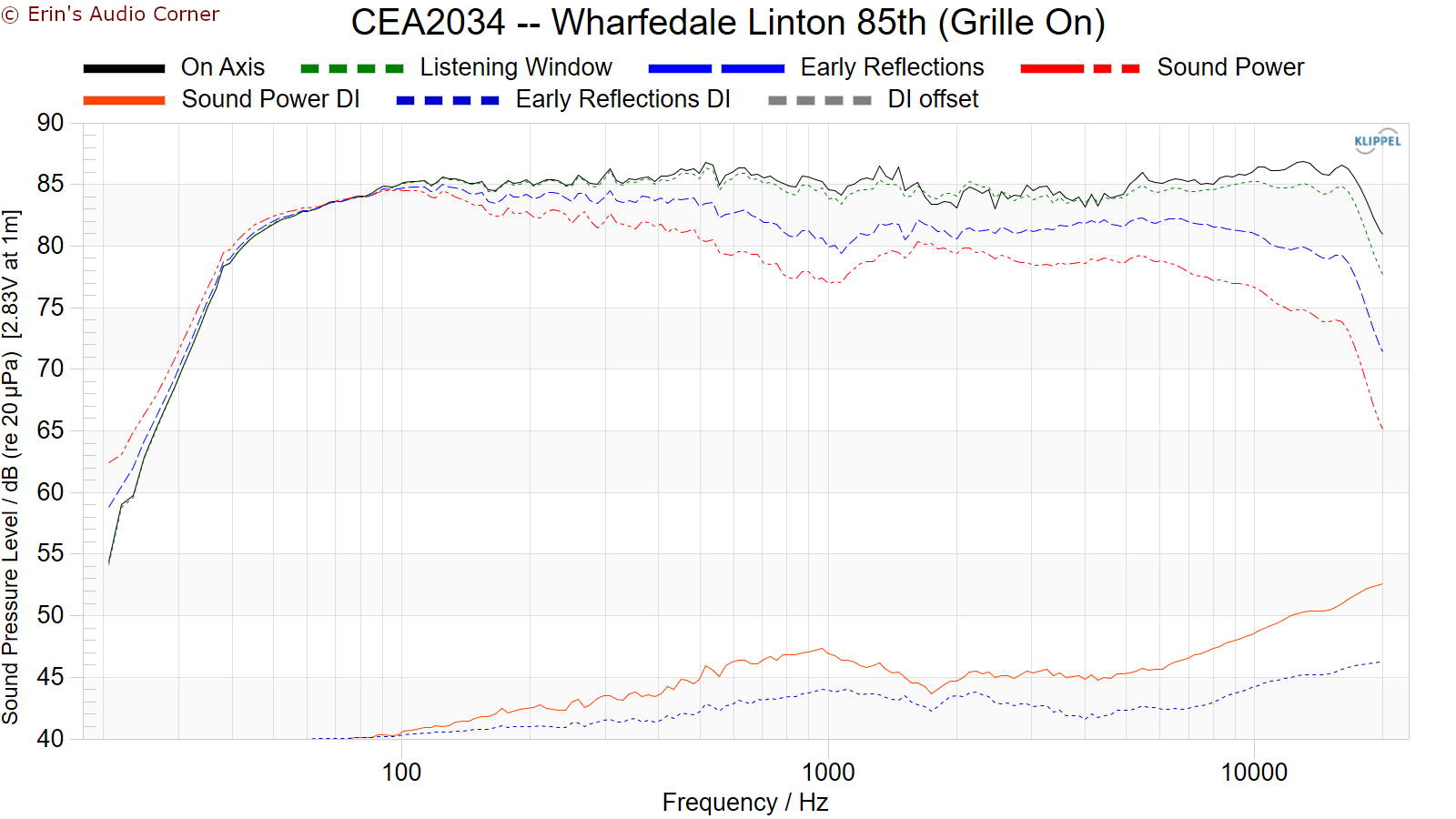
Grille Off:

Early Reflections Breakout:
Floor bounce: average of 20º, 30º, 40º down
Ceiling bounce: average of 40º, 50º, 60º up
Front wall bounce: average of 0º, ± 10º, ± 20º, ± 30º horizontal
Side wall bounces: average of ± 40º, ± 50º, ± 60º, ± 70º, ± 80º horizontal
Rear wall bounces: average of 180º, ± 90º horizontal
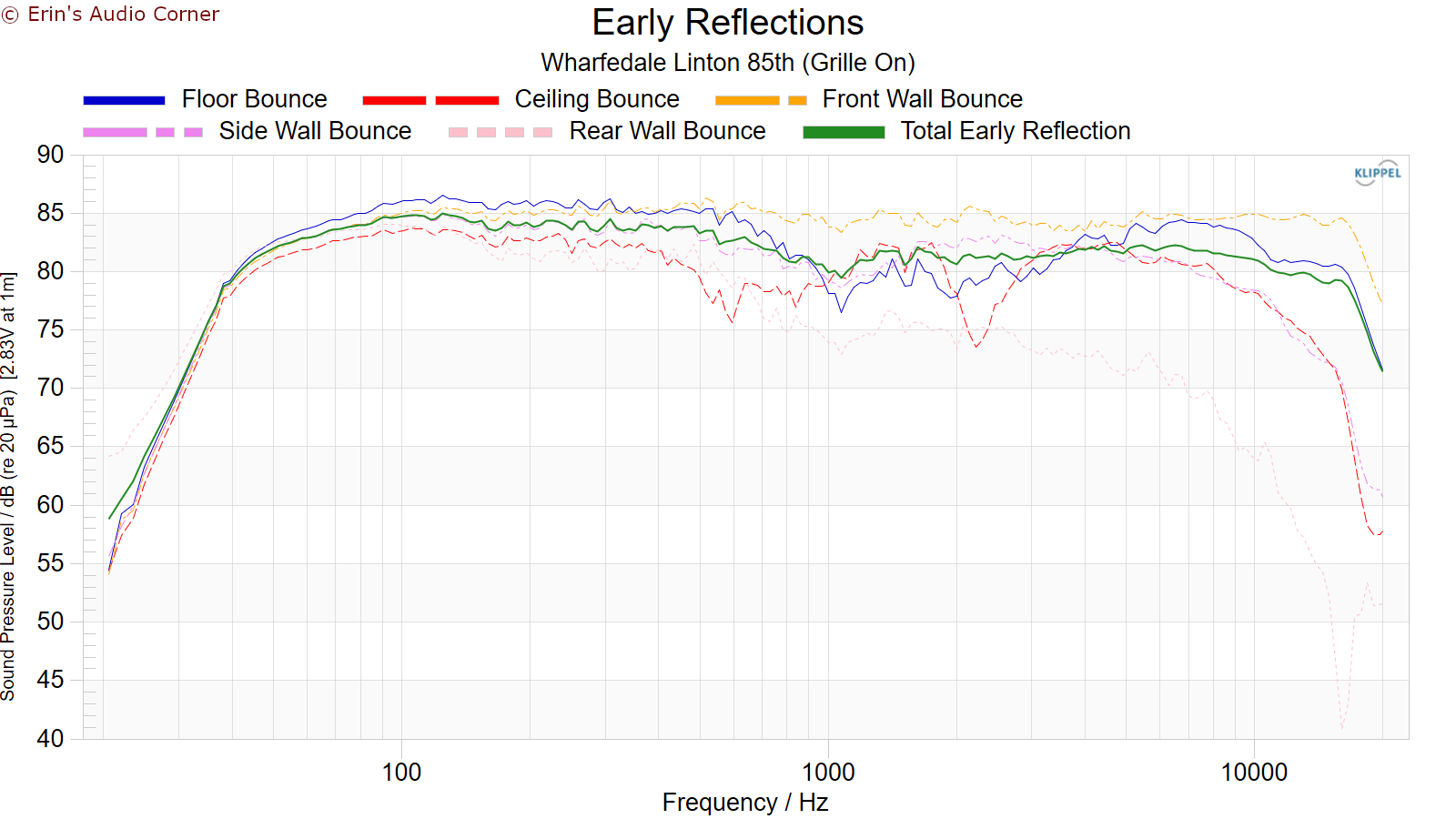
Estimated In-Room Response:
In theory, with complete 360-degree anechoic data on a loudspeaker and sufficient acoustical and geometrical data on the listening room and its layout it would be possible to estimate with good precision what would be measured by an omnidirectional microphone located in the listening area of that room. By making some simplifying assumptions about the listening space, the data set described above permits a usefully accurate preview of how a given loudspeaker might perform in a typical domestic listening room. Obviously, there are no guarantees, because individual rooms can be acoustically aberrant. Sometimes rooms are excessively reflective (“live”) as happens in certain hot, humid climates, with certain styles of interior décor and in under-furnished rooms. Sometimes rooms are excessively “dead” as in other styles of décor and in some custom home theaters where acoustical treatment has been used excessively. This form of post processing is offered only as an estimate of what might happen in a domestic living space with carpet on the floor and a “normal” amount of seating, drapes and cabinetry.
For these limited circumstances it has been found that a usefully accurate Predicted In-Room (PIR) amplitude response, also known as a “room curve” is obtained by a weighted average consisting of 12 % listening window, 44 % early reflections and 44 % sound power. At very high frequencies errors can creep in because of excessive absorption, microphone directivity, and room geometry. These discrepancies are not considered to be of great importance.

Horizontal Frequency Response (0° to ±90°):

Vertical Frequency Response (0° to ±40°):
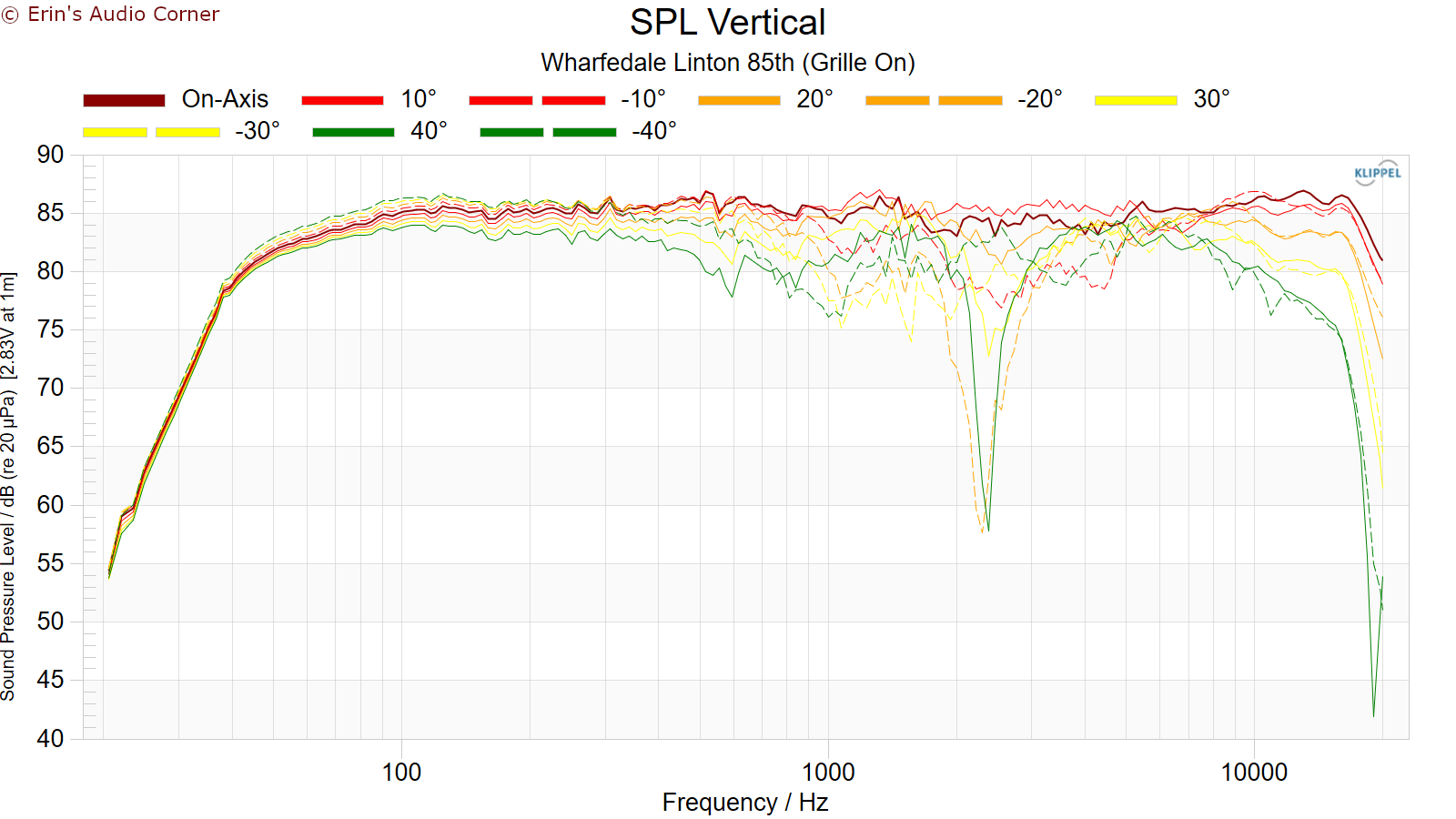
Horizontal Contour Plot (normalized):

Vertical Contour Plot (normalized):
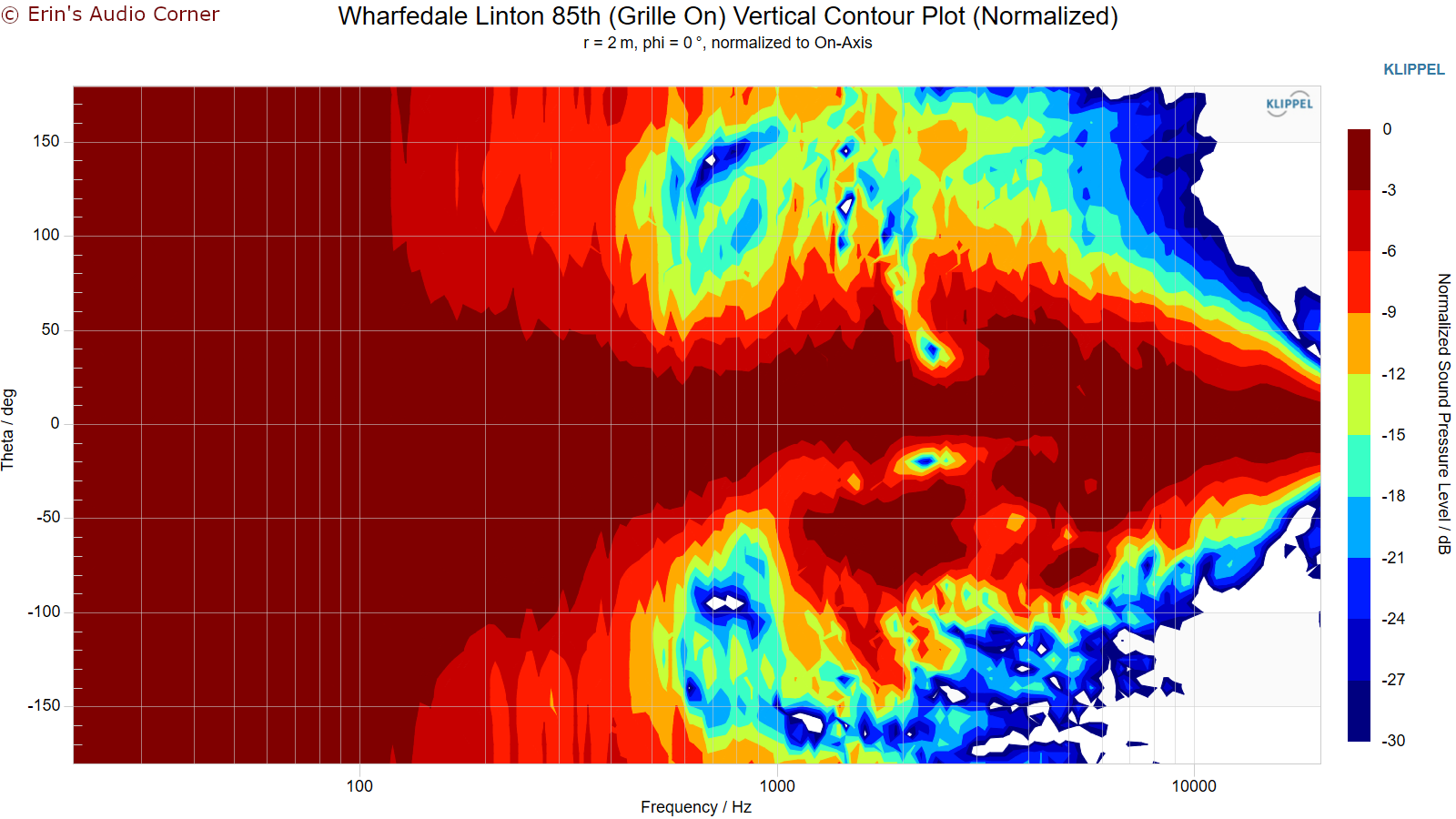
“Globe” Plots
Horizontal Polar (Globe) Plot:
This represents the sound field at 2 meters - above 200Hz - per the legend in the upper left.
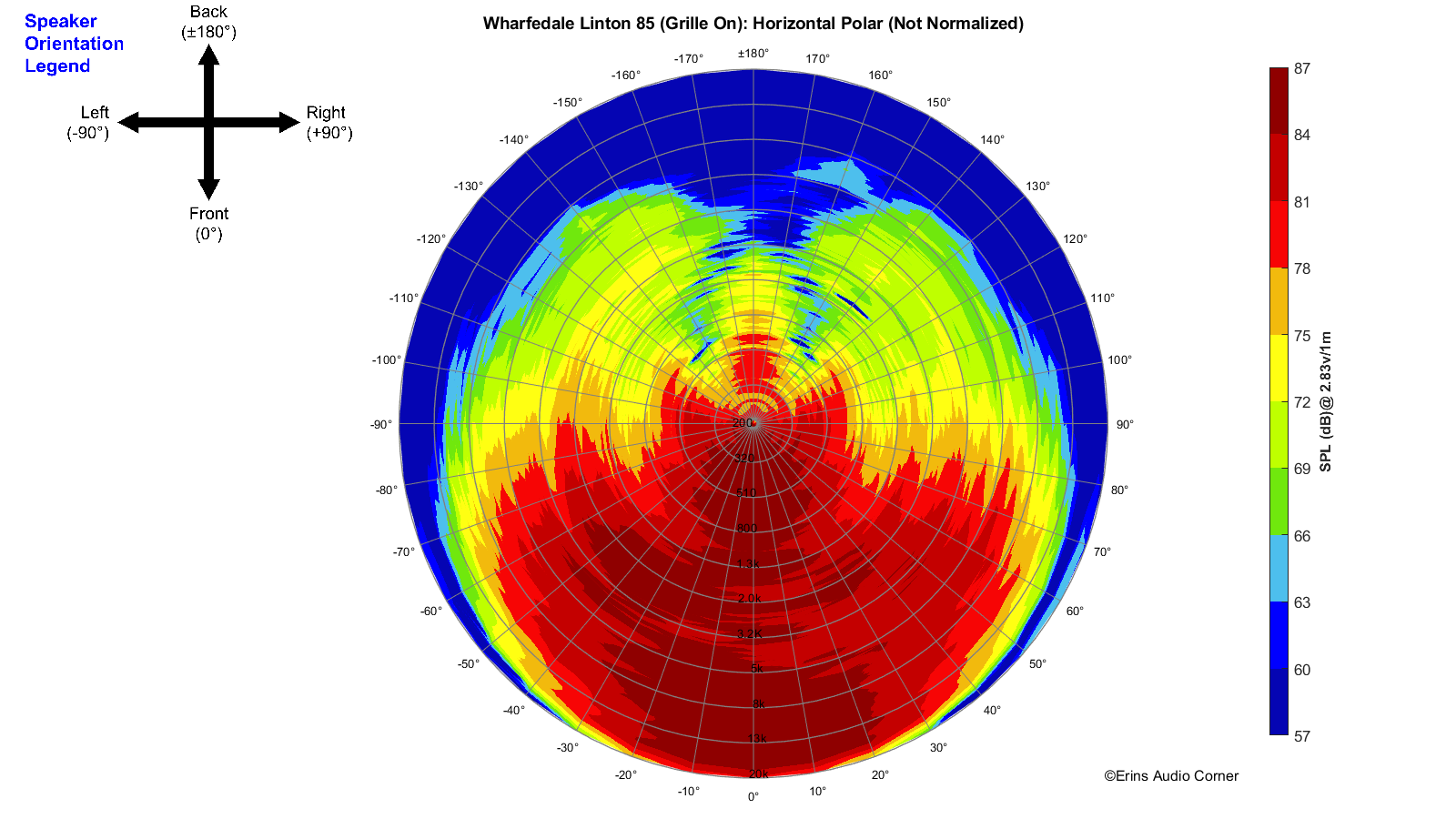
Vertical Polar (Globe) Plot:
This represents the sound field at 2 meters - above 200Hz - per the legend in the upper left.

Additional Measurements
Response Linearity

Impedance Magnitude and Phase
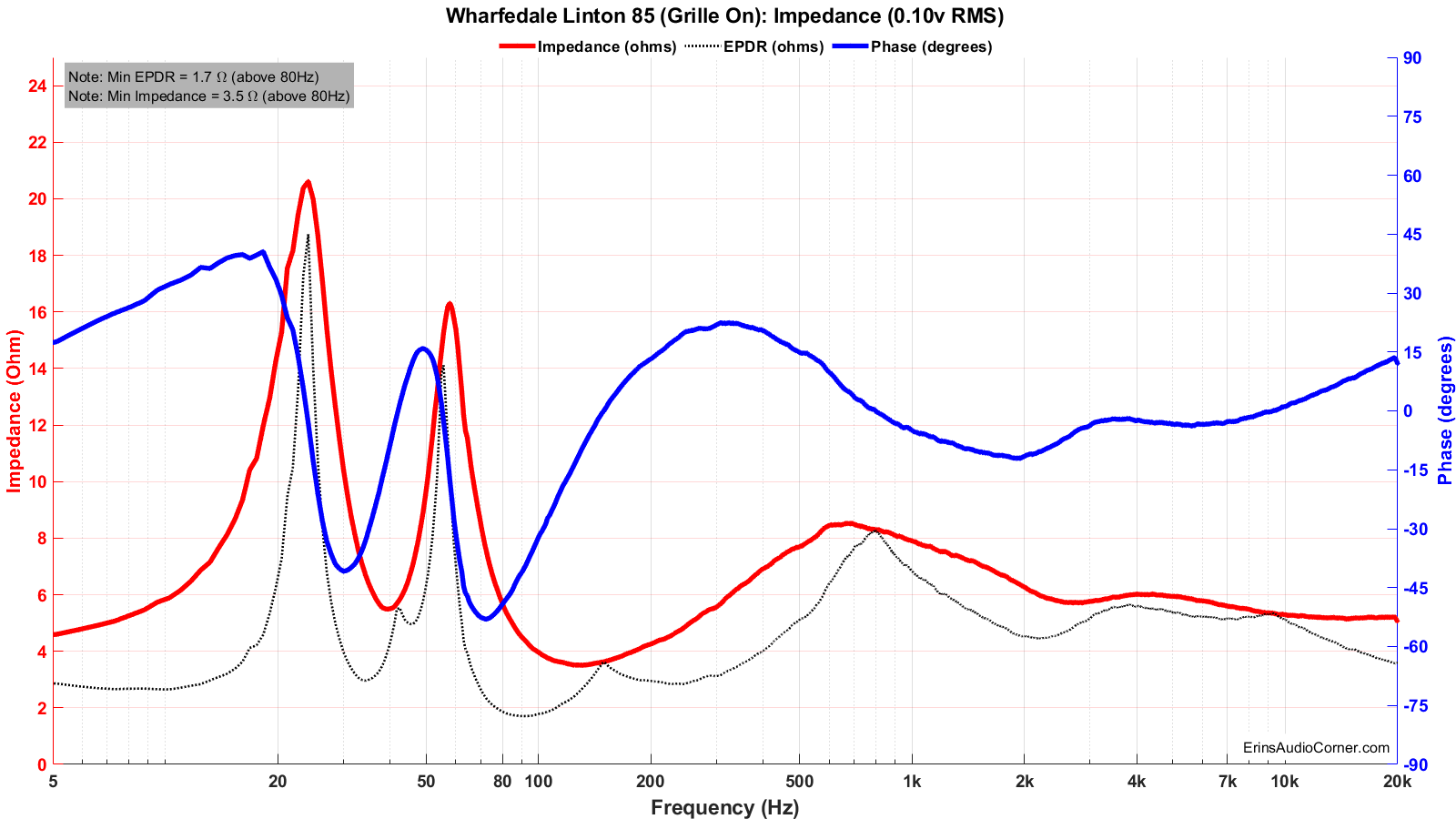
Step Response

Group Delay
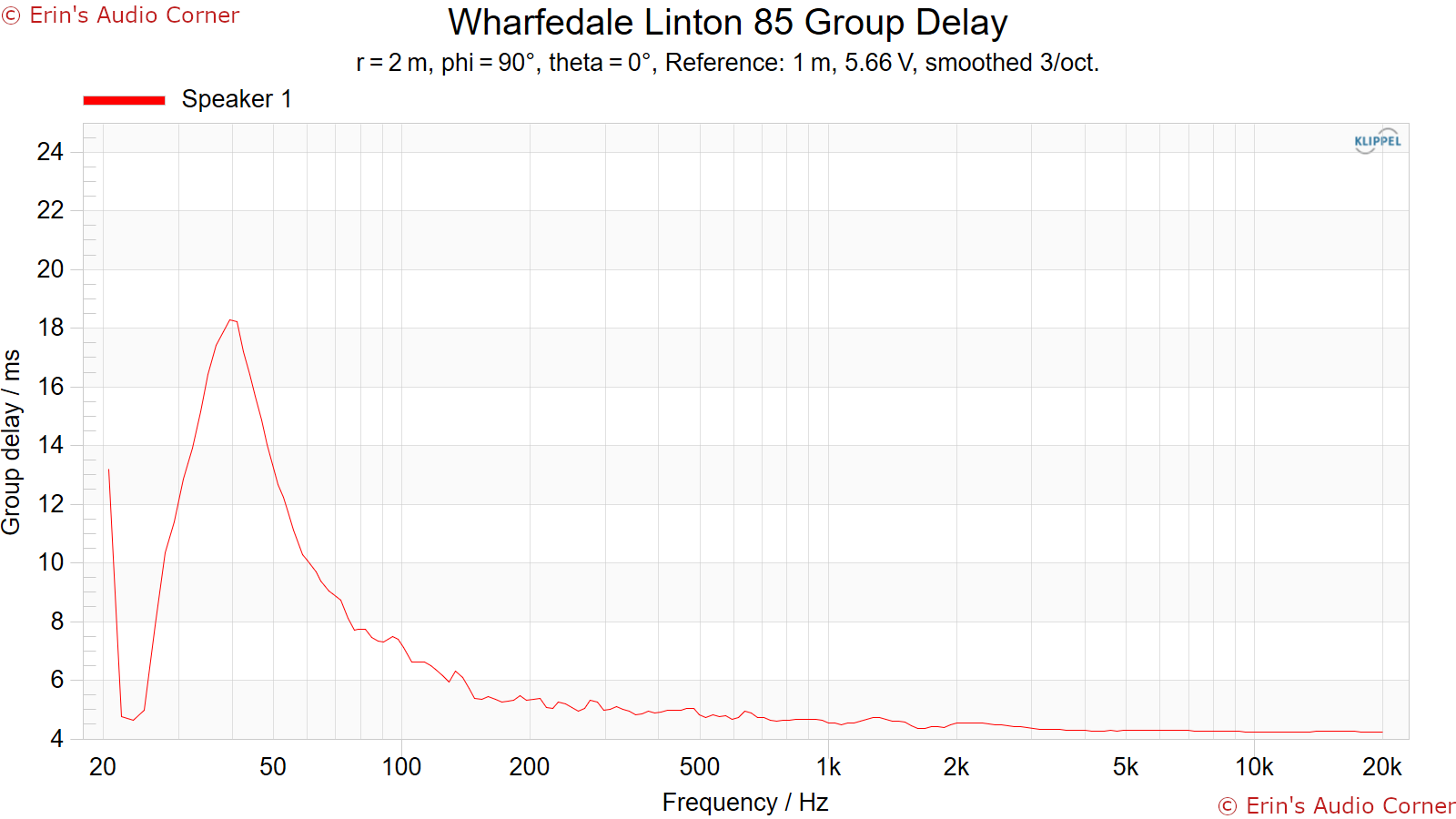
Harmonic Distortion
Harmonic Distortion at 86dB @ 1m:
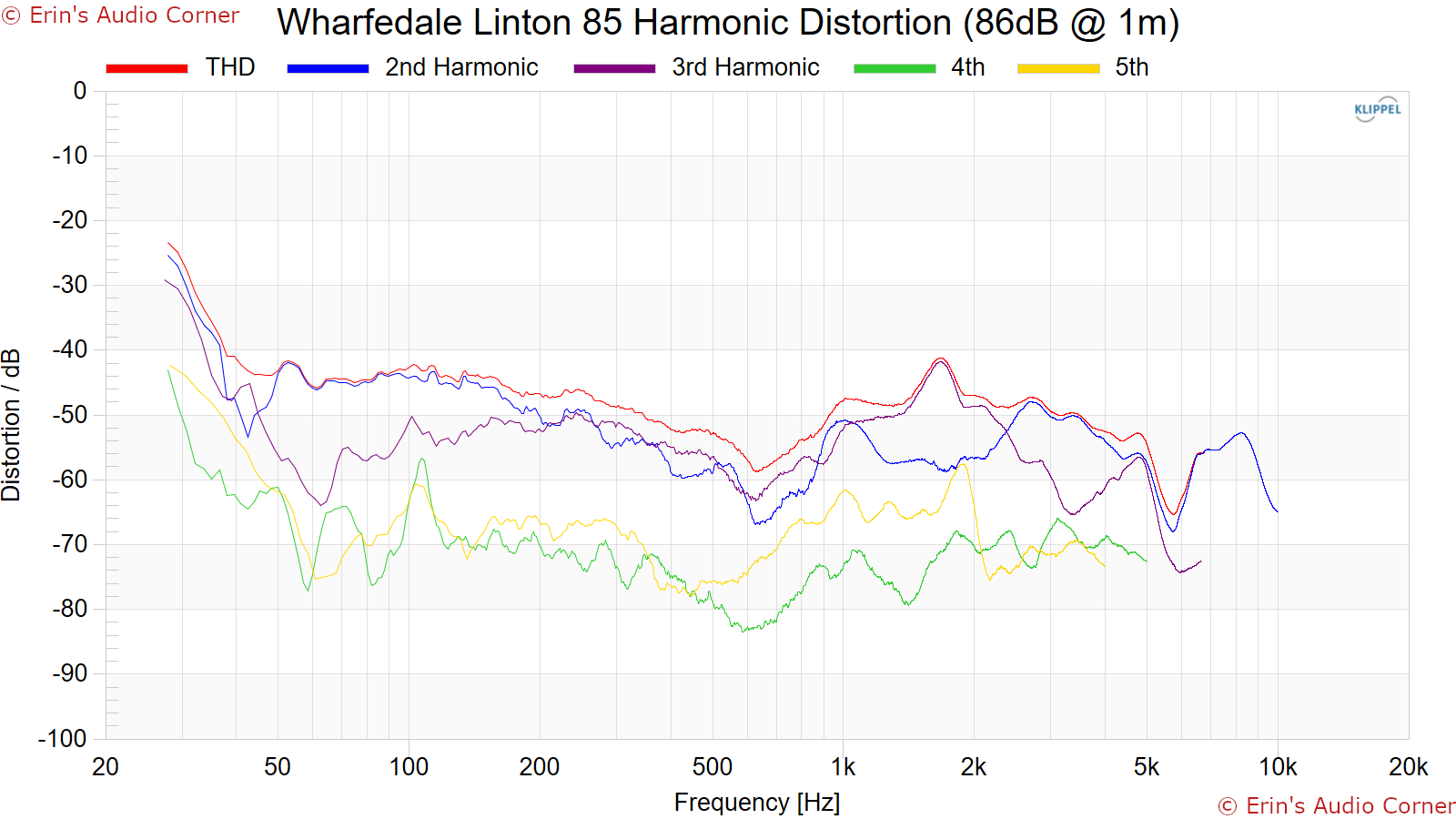
Harmonic Distortion at 96dB @ 1m:
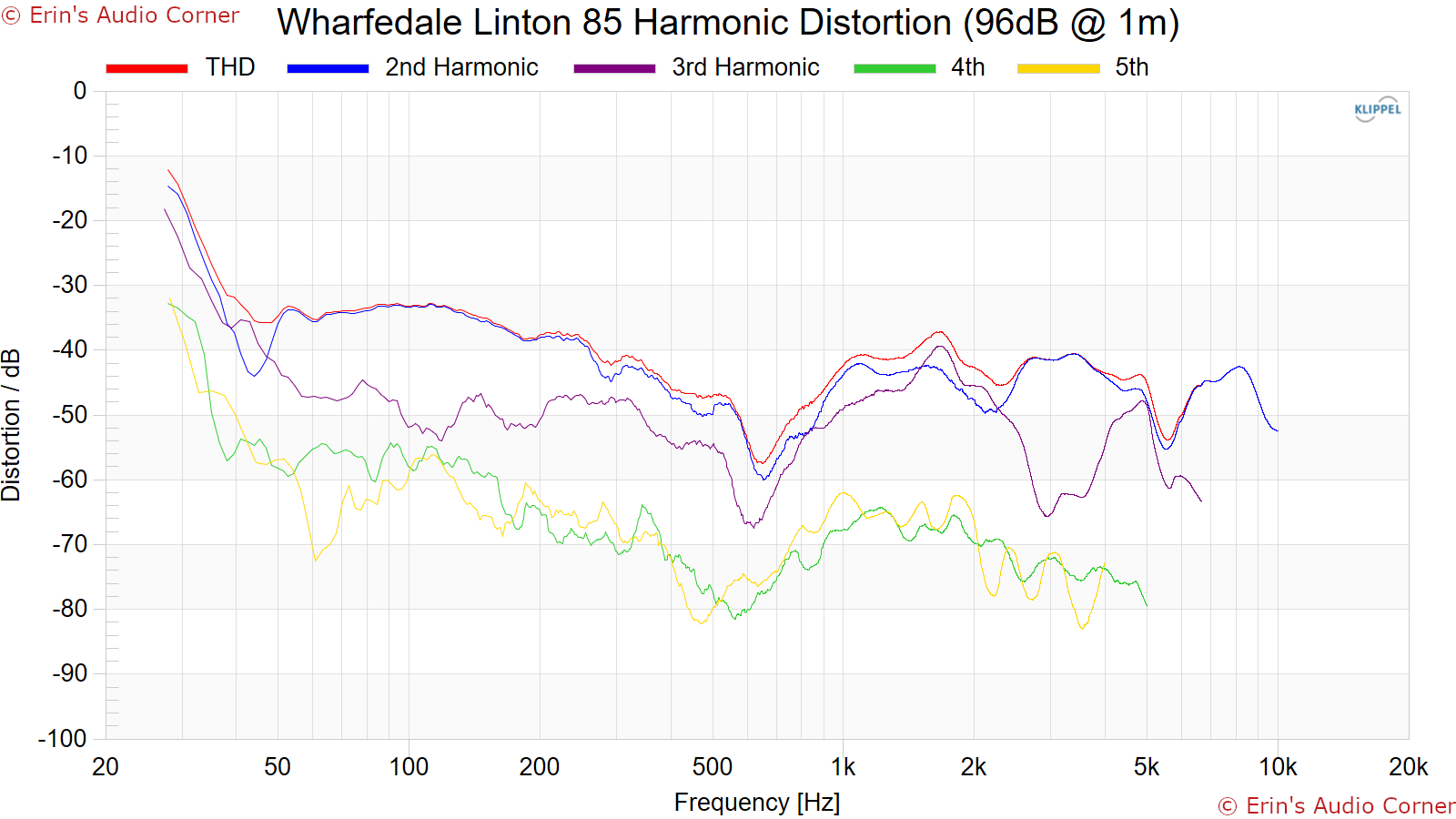
Dynamic Range (Instantaneous Compression Test)
The below graphic indicates just how much SPL is lost (compression) or gained (enhancement; usually due to distortion) when the speaker is played at higher output volumes instantly via a 2.7 second logarithmic sine sweep referenced to 76dB at 1 meter. The signals are played consecutively without any additional stimulus applied. Then normalized against the 76dB result.
The tests are conducted in this fashion:
- 76dB at 1 meter (baseline; black)
- 86dB at 1 meter (red)
- 96dB at 1 meter (blue)
- 102dB at 1 meter (purple)
The purpose of this test is to illustrate how much (if at all) the output changes as a speaker’s components temperature increases (i.e., voice coils, crossover components) instantaneously.
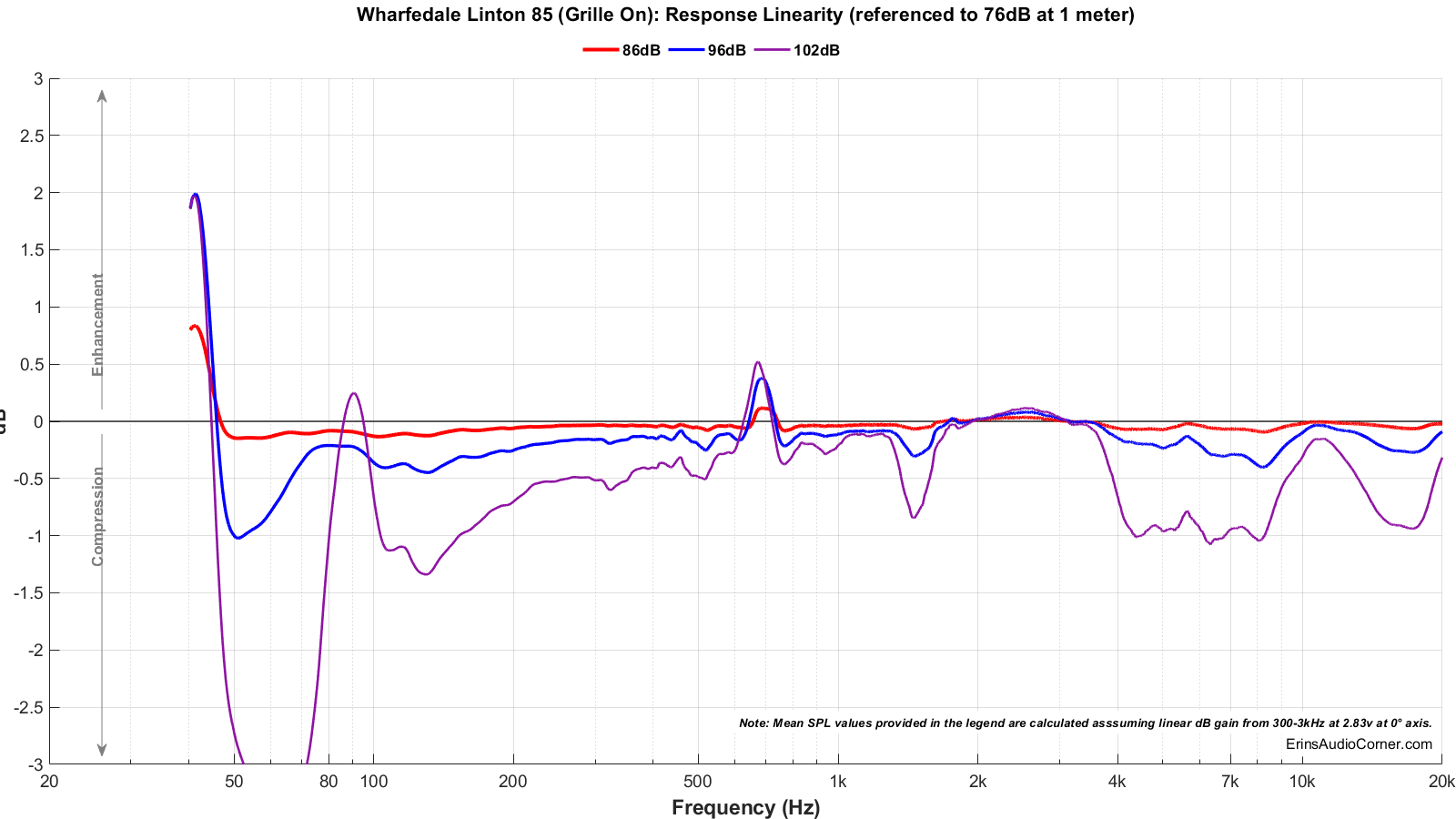
Multitone Distortion
The following tests are conducted at (4) approximate equivalent output volumes: 70/79/87/96dB @ 1 meter. The (4) voltages listed in the legend result in these SPL values.
The test was conducted in (3) manners:
- Full bandwidth (20Hz to 20kHz)
- 80Hz to 20kHz
The reason for the two measurements is to simulate running the speaker full range vs using a high-pass filter at 80Hz. However, note: the 2nd test low frequency limit at 80Hz is a “brick wall” and doesn’t quite emulate a standard filter of 12 or 24dB/octave. But… it’s close enough.
For information on how to read the below data, watch this video:
- Full bandwidth (20Hz to 20kHz)

- 80Hz to 20kHz

Parting / Random Thoughts
As stated in the Foreword, this written review is purposely a cliff’s notes version. For details about the performance (objectively and subjectively) please watch the YouTube video. But a couple quick notes based on my listening and what I see in the data:
- This is truthfully one of my favorite speakers so far. On sight, I half expected this speaker to sound quite colored and have resonances; an experience I had with the Klipsch Heresy IV. However, my subjective listening experience was the complete opposite. For the first time in a while I found myself going through an extensive number of songs and just enjoying the music. There were no “standouts” that bothered me and pulled me “out of my element”. Even upon additional listening sessions I continued to find myself more and more happy with the sound from the Lintons.
- These speakers extend to about 40Hz in my room (50Hz anechoic F3) and play with plenty of volume if you choose to crank them up. There was no screeching at high level or no graininess to the sound with increased volume. And at lower volume levels the dynamics were still there thanks to the very neutral midbass to midrange transition that didn’t call attention to itself via resonance like so many rectangle speakers tend to do.
- Construction seems good overall and I like that the midrange driver has its own enclosure inside the speaker. Not only does it have its own enclosure but the enclosure is round. Meaning there is less chance for standing waves compared to big rectangular speakers. There is also a liberal amount of insulation in the enclosure. Overall, I am really happy to see such thoughtfulness put into the build quality of this speaker.
- The soundstage width is impressive. At about ±70° through the upper midrange, it is wide but not so wide that it results in a diffuse soundstage (at least in my setups).
- Remember, the speaker performs best with the grille on.
- Stay at tweeter level. If you go even 10° above or below the tweeter level, the timbre of the speaker is noticeably different and worse.
- The treble can sound a touch bright. I played around with positioning and found that turning the speakers about 10° off-axis (firing out into the room; not cross-firing across the room) worked best to balance the HF with soundstage width.
- There really isn’t much about this speaker I’d change. The only complaint I have in my notes is in regard to the snare not having quite the “attack” I’d expect. The data shows a dip through this region so I think that’s likely what I was hearing. Therefore, I might, might consider evaluating the crossover between the midrange and tweeter and bring that down a bit, if possible just to get better directivity matching in the 1-2kHz region. But this would be a pretty low objective on my list. I’d probably never get around to it. I’d just enjoy them for what they are.
- The data shows a very linear speaker within about ±2dB above about 70Hz and an F3 of 50Hz, putting typical in-room extension to around 40Hz. Horizontal directivity looks really good until around 1-2khz where the tweeter crossover is. Sensitivity is about 85dB @ 2.83v/1m.
- Something interesting and possibly (or not at all) related to my positive listening experience: this speaker has a larger than typical front baffle width. Which means it provides more directivity at lower frequencies than many bookshelf and tower speakers. This means that the speaker is mostly radiating in the front hemisphere at a lower frequency than its slimmer counterparts.
Overall, point blank, one of my favorite speakers to date and I think I’d have to put this as number one in its price range. Off the top of my head, I can’t think of a better $1500/pair speaker I’ve heard to date. If I were shopping, these would be at the top of my list for speakers to demo in my home against others before I made the final decision. Make sure you try with the grille on and off and I suggest toeing them out by about 10° for best tradeoff between tonality, soundstage width and imaging.
Support / Contribute
If you find this review helpful and want to help support the cause that would be AWESOME! There are a few ways you can do so below. Your support helps me pay for new items to test, hardware, miscellaneous items needed for testing, new speakers to review and costs of the site’s server space and bandwidth. Any help is very much appreciated.
Join my Patreon: Become a Patron!
Shopping
If you are shopping at any of the following stores then please consider using my generic affiliate links below to make the purchase through.
Purchases through these links can earn me a small commission - at no additional cost to you - and help me continue to provide the community with free content and reviews. Doesn’t matter if it’s a TV from Crutchfield, budget speakers from Audio Advice or a pair of socks from Amazon, just use the link above before you make your purchase. Thank you!